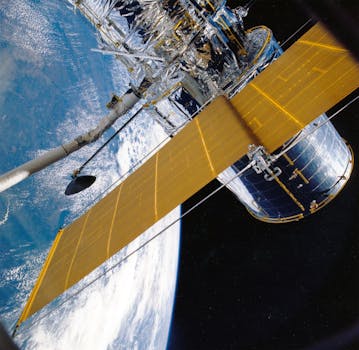
The Future of Satellites: Revolutionizing Global Communication and Exploration. The future of satellites is a rapidly evolving field, with significant advancements in technology and investment in space infrastructure. Satellites have been a crucial part of modern life, providing global communication, navigation, and weather forecasting. However, the next generation of satellites is expected to have a profound impact on various aspects of our lives, from internet connectivity to space exploration.
One of the most significant developments in the future of satellites is the launch of satellite constellations, which involve a large number of small satellites working together to provide global coverage. Companies like SpaceX, Amazon, and OneWeb are investing heavily in these constellations, with the goal of providing high-speed internet connectivity to remote and underserved areas. This technology has the potential to bridge the digital divide, enabling millions of people to access the internet and participate in the global economy.
The future of satellites also holds great promise for space exploration. With the development of reusable launch vehicles and advancements in propulsion technology, satellites are becoming increasingly important for deep space missions. NASA and other space agencies are planning to use satellites to explore the moon, Mars, and other celestial bodies, with the goal of expanding our understanding of the universe and potentially establishing human settlements.
In addition to communication and exploration, satellites are also playing a critical role in monitoring the environment and mitigating the effects of climate change. Satellites are being used to track deforestation, monitor ocean health, and predict weather patterns, providing valuable insights for scientists and policymakers. The European Space Agency’s Copernicus program, for example, is using satellites to monitor the environment and provide data for climate modeling and mitigation strategies.
Advancements in Satellite Technology
The future of satellites is being driven by significant advancements in technology, including improvements in materials, propulsion systems, and satellite design. One of the most important developments is the use of small satellites, which are lighter, cheaper, and more efficient than traditional satellites. Small satellites are being used for a variety of applications, from earth observation to communication, and are enabling new missions and capabilities that were previously not possible.
Another area of advancement is in propulsion technology, with the development of new engines and fuels that are more efficient and environmentally friendly. Electric propulsion systems, for example, are being used to extend the life of satellites and reduce the amount of fuel needed for station-keeping and maneuvering. This technology is also enabling new mission concepts, such as satellite servicing and debris removal.
The use of artificial intelligence and machine learning is also becoming increasingly important in the future of satellites. AI and ML algorithms are being used to analyze data from satellites, providing insights and patterns that would be difficult or impossible to detect by human analysts. This technology is being used for a variety of applications, from earth observation to communication, and is enabling new capabilities and missions that were previously not possible.
Challenges and Opportunities
Despite the many advantages and opportunities presented by the future of satellites, there are also significant challenges and risks. One of the most significant concerns is the growing problem of space debris, which poses a threat to operational satellites and the environment. The proliferation of satellites in low earth orbit is also raising concerns about congestion and interference, which could impact the performance and reliability of satellite systems.
Another challenge is the need for international cooperation and regulation, to ensure that the benefits of satellite technology are shared equitably and that the risks are mitigated. The United Nations Committee on the Peaceful Uses of Outer Space (COPUOS) is working to develop new guidelines and regulations for the use of satellites, but more needs to be done to address the complex and evolving nature of the satellite industry.
Despite these challenges, the future of satellites holds great promise and opportunity. The development of new technologies and capabilities is enabling new missions and applications, from satellite servicing to lunar and planetary exploration. The growth of the satellite industry is also creating new jobs and opportunities, from engineering and manufacturing to operations and management.
